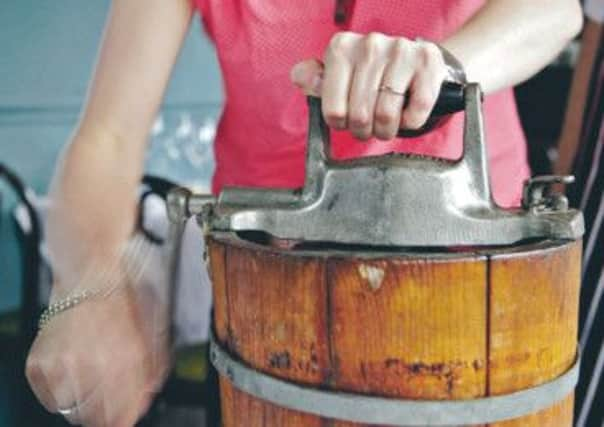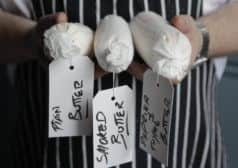Home butter kitchen gadget sales soar


But for now, home butter churners are the new culinary must-have – with sellers of the product reporting an 800 per cent spike in sales.
Both traditional hand churns and modern electric versions – which can cost up to £900 for the smallest, kitchen size model that produces 10 litres of butter – are flying off the shelves at dairy supplier Ascott, one of the few vendors of the product in the UK.
Advertisement
Hide AdAdvertisement
Hide AdDirector Mark Self has seen sales of his £90 five-litre hand churns rocket from the occasional sale of one a month to at least two a week over the past six months, with the greatest demand coming from crofters in the Highlands and Islands.


Wooden butter pats – a mould used to shape butter into blocks once it has been made – are also selling well, at a rate of almost 30 a month.
The trend of making butter at home has migrated from the US, where butter churning parties – when hosts ask guests to “BYOC” (Bring Your Own Cream) and take a turn at the arm-tiring churning – have become a regular social fixture among both homesteaders and hipster city dwellers.
“In the past six months we have sold quite a lot of equipment used for making butter at home,” said Self. “Butter making has really taken off. People sometimes find the old, antique butter churns at car boot sales or antique shops to use as decoration, but the ones they buy from us are definitely to make butter. For people to actually seek out a new butter churn isn’t a whim.”
Self said he believed the trend to make butter at home would continue.
“Things like bread makers or pasta machines can be a fad – or a lot of them would be bought by people as presents,” he said.
“Buying a butter churn is a different thing altogether – people would only spend that money if they were serious about continuing with it.”
Ross Boyce, who appeared on last year’s MasterChef competition and runs a food and drink recruitment consultancy in Edinburgh, started making his own butter at home last year after seeing it done in top restaurants including the Three Chimneys on the Isle of Skye, where he spent a week as part of his chef’s training.
Advertisement
Hide AdAdvertisement
Hide AdFlavoured butters, which are used in sauces or to melt over vegetables or meat, have enjoyed a culinary renaissance in recent years.
“It is massively different to the stuff that you buy in shops,” he said. “I do it out of real geekery – I just get really into the technology of it. Butter is quite an in thing at the moment everywhere – in the top restaurants they are making things like whipped butter or bone marrow butter, which is fantastic.
“I make it for myself and my family to eat at home – or for friends. It really is a totally different flavour, you can almost eat it like cheese.”
In addition to domestic butter churns, Ascott also sells larger versions of the gadget in response to a growing demand from restaurants.
Chef Mark Greenaway, who appeared on the Great British Menu and runs his eponymous restaurant on Edinburgh’s North Castle Street, experimented in making butter to use in his food earlier this year, but abandoned the project as too pricey.
“To buy enough double cream to make as much butter as we would need in the restaurant just wasn’t economic,” he said.
However, Greenaway said making butter at home would produce a more pure version of the product and also allow keen chefs to add flavours such as herbs and spices earlier on in the butter-making process.
“In essence, it is a great idea because you can control exactly what is in it,” he said. “You’re not always guaranteed that if you buy butter, what you are getting. Especially at the budget end of the market, it can contain oils so I can understand why people would want to get back to basics.”
Twitter: @janekbradley